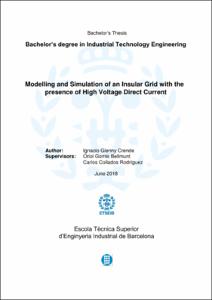Mostra el registre d'ítem simple
Modelling and simulation of an insular grid with the presence of High Voltage Direct Current
| dc.contributor | Gomis Bellmunt, Oriol |
| dc.contributor | Collados Rodríguez, Carlos |
| dc.contributor.author | Glenny Crende, Ignacio |
| dc.contributor.other | Universitat Politècnica de Catalunya. Departament d'Enginyeria Elèctrica |
| dc.coverage.spatial | east=2.6463999918794343; north=39.56800771130738; name=Av. d'Antoni Maura, 3A, 07012 Palma, Illes Balears, Espanya |
| dc.date.accessioned | 2019-09-03T06:23:34Z |
| dc.date.available | 2019-09-03T06:23:34Z |
| dc.date.issued | 2018-06-21 |
| dc.identifier.uri | http://hdl.handle.net/2117/167860 |
| dc.description.abstract | Insular electrical grids, usually isolated from larger mainland grids, are more prone to having stability issues. These are usually weak and have limited resources in regards to power sources, which adds up with the fact that this type of grids usually lack access to the electricity market. High Voltage Direct Current (HVDC) technology presents the possibility of long distance overseas connections that alleviate the effects of these issues. Use of HVDC technology is on the rise, its main focus being long distance transport of power. Its effciency and the stability it provides to grids, paired with the aforementioned need for overseas connections and off-shore wind generation have helped it become as common as it is nowadays. The aim of this thesis is to study the behaviour of an insular grid with the presence of HVDC and the needed power converter for the HVDC connection. The behaviour of the system with and without the converter's frequency support will be analyzed. A case based on the Majorcan 220kV grid (Balearic Islands, Spain) with an HVDC connection representing a link with the mainland is used to analyze the behaviour of an insular grid with and without the frequency support. HVDC presence in the grid is represented by a converter modelled as seen in ”Active and Reactive Power Control of Grid Connected Distributed Generation Systems” [1]. The tools used for modelling and simulating are MatLab® 2015b and PSCAD 4.6 EDU. MatLab® is used for running steady state simulations of the grid's behaviour and for initial modelling of the VSC converter. For the first, the MATPOWER X.Y package is used. In regards to the former, the Simulink environment is used. PSCAD is used for dynamic analysis of the grid, with and without the power converter's grid frequency support. Comparison of the MatLab® 2015b and PSCAD 4.6 EDU simulations show that the dynamic model behaves as it is expected from it. There are no relevant differences from the dynamic and the static models' results. The study of the dynamic behaviour of the system in front of a fault shows that the HVDC connection's grid frequency support alleviates the negative impact that said events have on the grid's frequency. This is done while also reducing the amount of power that needs to be generated with the limited local resources. |
| dc.language.iso | eng |
| dc.publisher | Universitat Politècnica de Catalunya |
| dc.rights.uri | http://creativecommons.org/licenses/by-nc-nd/3.0/es/ |
| dc.subject | Àrees temàtiques de la UPC::Enginyeria elèctrica::Alta tensió |
| dc.subject.lcsh | Electric currents, Direct |
| dc.subject.lcsh | Electric current converters |
| dc.subject.lcsh | High voltages |
| dc.title | Modelling and simulation of an insular grid with the presence of High Voltage Direct Current |
| dc.type | Bachelor thesis |
| dc.subject.lemac | Corrents continus |
| dc.subject.lemac | Convertidors de corrent elèctric |
| dc.subject.lemac | Alta tensió |
| dc.identifier.slug | ETSEIB-240.135276 |
| dc.rights.access | Open Access |
| dc.date.updated | 2018-07-13T05:25:27Z |
| dc.audience.educationlevel | Grau |
| dc.audience.mediator | Escola Tècnica Superior d'Enginyeria Industrial de Barcelona |
| dc.audience.degree | GRAU EN ENGINYERIA EN TECNOLOGIES INDUSTRIALS (Pla 2010) |


